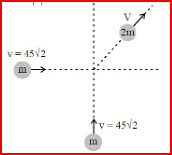Question:
Two putty balls of equal mass moving with equal velocity in mutually perpendicular directions, stick together after collision. If the balls were initially moving with a velocity of $45\sqrt{2}$ m/sec each, the velocity of their combined mass after collision is (in m/sec).
Two putty balls of equal mass moving with equal velocity in mutually perpendicular directions, stick together after collision. If the balls were initially moving with a velocity of $45\sqrt{2}$ m/sec each, the velocity of their combined mass after collision is (in m/sec).
Updated On: Aug 8, 2024
- \(45\sqrt{2}\)
- 45
- 90
- $22.5\sqrt{2}$
Hide Solution
Verified By Collegedunia
The Correct Option is B
Solution and Explanation
Initial momentum
\(\vec{P} = m45\sqrt{2} \hat{i} + m45\sqrt{2} \hat{j}\)
\(\Rightarrow\quad\left|\vec{P}\right| = m\times90\)
Final momentum 2m ? V
By conservation of momentum
2m ? V = m ? 90
\(\therefore\) V = 45 m/s

So, the correct option is(B): 45.
\(\vec{P} = m45\sqrt{2} \hat{i} + m45\sqrt{2} \hat{j}\)
\(\Rightarrow\quad\left|\vec{P}\right| = m\times90\)
Final momentum 2m ? V
By conservation of momentum
2m ? V = m ? 90
\(\therefore\) V = 45 m/s

So, the correct option is(B): 45.
Was this answer helpful?
2
2
Top Questions on Elastic and inelastic collisions
- Two particles, 1 and 2, each of mass 𝑚, are connected by a massless spring, and are on a horizontal frictionless plane, as shown in the figure. Initially, the two particles, with their center of mass at \(𝑥_0\), are oscillating with amplitude 𝑎 and angular frequency 𝜔. Thus, their positions at time 𝑡 are given by \(x_1 (t) = (x_0 + d) + \alpha \ sin \omega t\) and \(x_2t = (x_0 -d) − \alpha sin \ wt,\) respectively, where \(𝑑 > 2𝑎.\) Particle 3 of mass 𝑚 moves towards this system with speed 𝑢0 = 𝑎𝜔/2, and undergoes instantaneous elastic collision with particle 2, at time \(𝑡_0\). Finally, particles 1 and 2 acquire a center of mass speed \(𝑣_{cm}\) and oscillate with amplitude 𝑏 and the same angular frequency 𝜔.

- JEE Advanced - 2024
- Physics
- Elastic and inelastic collisions
- Choose the option showing the correct relation between Poisson’s ratio (σ), Bulk modulus (B) and modulus of rigidity (G).
- JEE Main - 2023
- Physics
- Elastic and inelastic collisions
- A uniform heavy rod of mass \(20\) kg, cross sectional area \(0.4\) \(m^2\) and length \(20\) \(m\) is hanging from a fixed support. Neglecting the lateral contraction, the elongation in the rod due to its own weight is \(x × 10^{–9}\) \(m\). The value of \(x\) is _____(Given Young’s modulus \(Y = 2 × 10^{11} Nm^{–2}\)and g = \(10\; ms^{–2})\)
- JEE Main - 2022
- Physics
- Elastic and inelastic collisions
- Which one of the following is the correct statement?
- KEAM - 2022
- Physics
- Elastic and inelastic collisions
- A ball hits the floor and rebounds after an inelastic collision. In this case
- KCET - 2021
- Physics
- Elastic and inelastic collisions
View More Questions
Questions Asked in JIPMER exam
- Binomial nomenclature was first introduced by
- JIPMER - 2015
- KCET - 2022
- Diversity In The Living World
- A convex lens $'A'$ of focal length $20\, cm$ and a concave lens $'B'$ of focal length $5\, cm$ are kept along the same axis with a distance $'d'$ between them. If a parallel beam of light falling on $'A'$ leaves $'B'$ as a parallel beam, then the distance $'d'$ in cm will be :
- JIPMER - 2021
- Spherical Mirrors
- A bacterial flagellum is composed of
- JIPMER - 2021
- Prokaryotic Cells
- $2,4-DNP $ test can be used to identify :
- JIPMER - 2021
- Chemical Reactions
- How many moles of acidified $K_2Cr_2O_7$ is required to liberate $6$ moles of $I_2$ from an aqueous solution of $I^-$ ?
- JIPMER - 2020
- Mole concept and Molar Masses
View More Questions
Concepts Used:
Elastic and Inelastic Collisions
Elastic Collision:
According to elastic collision, the kinetic energy of the system will remain constant which means there will be no change in the kinetic energy of the system before and after the collision. It also goes along with the conservation of momentum.
Examples of Elastic Collision
- While playing billiards, balls hit each other.
- A ball is thrown and is bounced to the same height it was thrown from, is an example of elastic collision as there is no net change in the kinetic energy.
- The collision of atoms is also an elastic collision.
Inelastic Collision:
According to inelastic collision, the kinetic energy of the system is not conserved, unlike inelastic collision. The kinetic energy is lost as it gets debauched in other forms of energy like heat, sound, etc, or is absorbed by the body. But they go after the conservation of momentum, like an elastic collision.
Examples of Inelastic Collision
- When the ball is dropped on the ground, it fails to reach the height it was dropped from.
- The accident of two vehicles is an inelastic collision.
- If the clay is thrown at a wall, it sticks to it.
Read More: Elastic and Inelastic Collision



